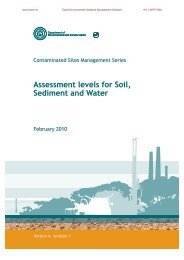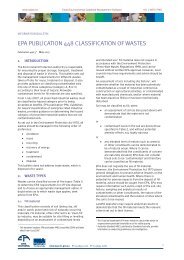Soil Generic Assessment Criteria for Human Health Risk ... - ESdat
Soil Generic Assessment Criteria for Human Health Risk ... - ESdat
Soil Generic Assessment Criteria for Human Health Risk ... - ESdat
You also want an ePaper? Increase the reach of your titles
YUMPU automatically turns print PDFs into web optimized ePapers that Google loves.
www.esdat.net Esdat Environmental Database Management Software +61 2 8875 7948<br />
unless there was more recent strong evidence to suggest that treatment as a non-threshold substance would be<br />
appropriate. In some cases, even if there was reasonable evidence of human carcinogenicity, there was insufficient<br />
dose-response data on non-threshold effects to derive an index dose and the HCV were there<strong>for</strong>e based on<br />
threshold effects alone.<br />
3.2.2<br />
Selection of recommended TDIs and IDs<br />
As far as possible, SR2 guidance on the selection of TDIs and IDs has been followed. As previously discussed, the<br />
SR2 guidance <strong>for</strong> derivation of HCV recommends the use of an expert toxicologist. This toxicologist should be able<br />
to evaluate the merits of alternative health criteria and, if required, derive HCV de novo (i.e. derive HCV directly<br />
from toxicological data). As discussed, none of the EIC/AGS/CL:AIRE GAC project volunteers were qualified<br />
toxicologists and there<strong>for</strong>e no attempt has been made to derive HCV de novo. Rather, TDIs and IDs were selected<br />
from the collated health criteria derived by national and international expert review groups. It should also be noted<br />
that the HCV <strong>for</strong> contaminants with SGV have in general been derived from existing health criteria from expert<br />
review groups as opposed to de novo. To ensure that a consistent approach was followed, the following protocol<br />
was derived and used <strong>for</strong> the derivation of HCV:<br />
• TDIs or IDs were not recommended if there were insufficient data with sufficient details on<br />
provenance. For example, <strong>for</strong> some contaminants, the only health criteria available were reference<br />
doses (RfD), reference concentrations (RfC) or carcinogenic slope factors given in web-based<br />
databases such as RAIS. These databases did not provide sufficient supporting data (such as<br />
details on the study that the health criteria was based on) to have confidence that the health<br />
criterion was suitable <strong>for</strong> derivation of an EIC/AGS/CL:AIRE GAC . In these cases, no TDI or ID were<br />
recommended.<br />
Methodology<br />
• In<strong>for</strong>mation sources labelled as draft with “do not cite or quote” have not been used to derive HCV,<br />
but are referred to in the pro<strong>for</strong>mas <strong>for</strong> in<strong>for</strong>mation.<br />
• Occupational exposure levels (OEL) have not been used to derive HCV, but OEL data are reported<br />
in the pro<strong>for</strong>mas <strong>for</strong> in<strong>for</strong>mation.<br />
• Insufficient data on dermal exposure toxicity were identified to enable the derivation of HCV<br />
<strong>for</strong> dermal exposure. In accordance with the Environment Agency of England and Wales SR2<br />
document, in the absence of data on dermal toxicity the HCV <strong>for</strong> oral exposure (where available)<br />
have been used <strong>for</strong> assessing dermal exposure in the CLEA model. For contaminants where no<br />
oral HCV has been derived, route-to-route extrapolation from inhalation data has been considered<br />
as discussed below.<br />
• Route-to-route extrapolation has been considered <strong>for</strong> substances where an HCV has been derived<br />
<strong>for</strong> only one route of exposure. The SR2 document cites IGHRC (2006) <strong>for</strong> guidance on the use of<br />
route-to-route extrapolation. Route-to-route extrapolation may under- (or over-) estimate toxicity<br />
due to differences in absorption, metabolism and mode of action between routes of exposure.<br />
Oral to inhalation extrapolation is only recommended when: (a) the critical toxicological effect is<br />
systemic (rather than at the initial site of contact); (b) first pass metabolism (i.e. metabolism in the<br />
liver) and/or metabolism in the gut are not significant; and (c) there is sufficient in<strong>for</strong>mation on<br />
the relative acute toxicity and/or bioavailability between routes of exposure. The IGHRC note that<br />
inhalation to oral extrapolation is less likely to underestimate toxicity because absorption in the<br />
gastrointestinal tract is typically lower than in the lungs.<br />
Of the 44 substances researched 19 had a recommended HCV oral<br />
but no HCV inhal<br />
and 3 had a<br />
recommended HCV inhal<br />
but no HCV oral<br />
. An initial review revealed that there were unlikely to be<br />
sufficient data to satisfy all three conditions <strong>for</strong> the 19 compounds with an HCV oral<br />
and no HCV inhal<br />
.<br />
14








